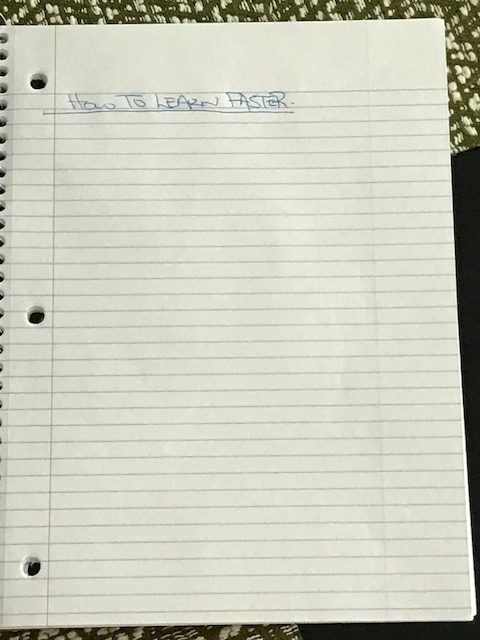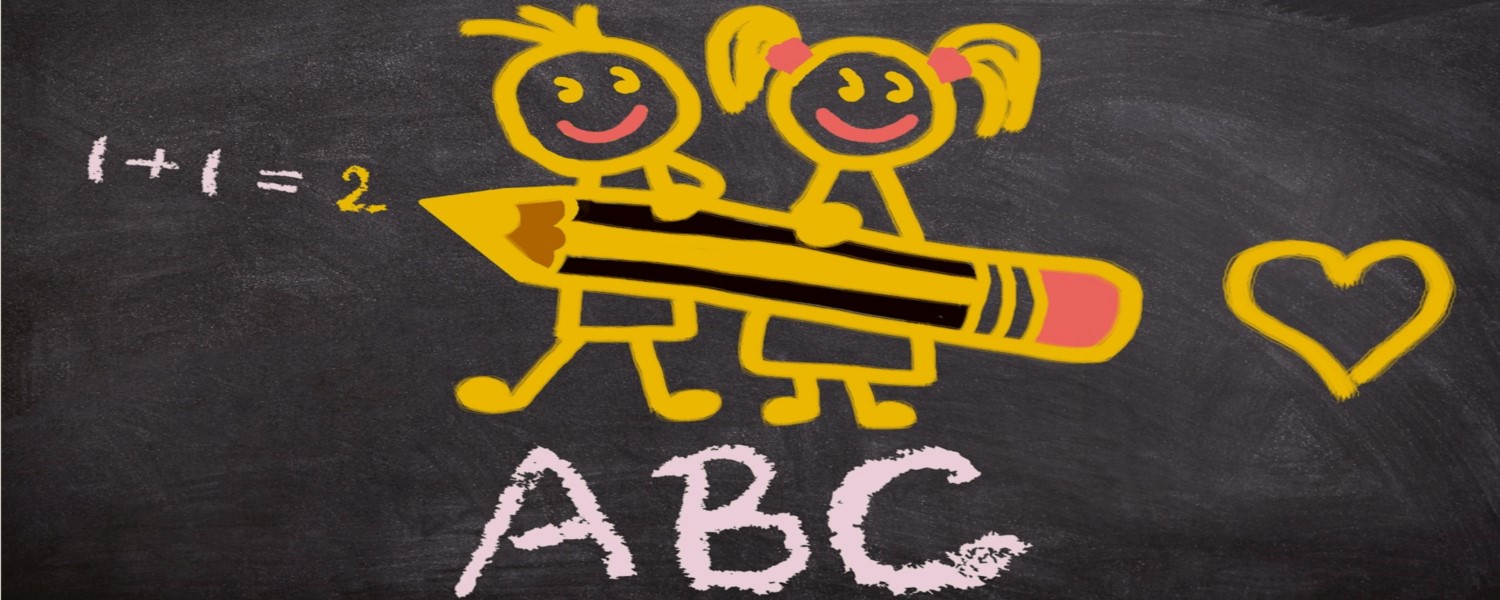This is How I Learned How to Learn Faster
Would you like to be able to learn faster? Seeing as how I constantly need to learn new things to write my blog posts, I figured it would probably be a good idea for me to learn how to learn faster, that way I could get more learning done in less time.
So, recently I did just that, I set out to learn how to learn faster. It turns out there are a whole bunch of secrets to learning that I had no idea about. Which is the topic of today’s post – how to learn faster. So, today we explore some universal secrets I have found that most research says will help you with respect to how to learn faster.
To learn how to learn faster, I started by…
(1) Writing down everything I knew about how to learn faster.
In the interest of time and to save me from typing everything out that I already knew, I snapped a photo of my notebook, presenting everything I knew about how to learn faster:

So, as you can see I knew a whole lot of not much. But hey, that’s what learning is all about!
Next, I started learning about how to learn faster and added to my notes page every time I learned something new. After a couple days of learning, I had learned a lot about how to learn faster and had quite a collection of notes.
I would share my notes with you but I’m pretty sure you would be unable to read my chicken scratch. So instead…
(2) I’ll teach you everything I have learned…

The first few things have nothing to do with how to learn faster itself, BUT they play just as or more important a role in how to learn faster…
You REALLY need to get your zzz’s!
One of the most important things you can do to learn faster and better is to make sure you get enough sleep, for a couple of reasons. One, when you are sleeping your brain has a chance to repair itself and clean out the toxins that are created when you are awake, which helps you think more clearly. Secondly, when you sleep your brain is connecting the concepts you have learned when you were awake while getting rid of the less important stuff in your memory.
Get your sweat on!
Exercise is a hugely underrated component of how to learn faster. The hippocampus is an area of the brain that is critical for learning new things. It turns out new neurons are born in our brain every day, and one of the places they are born is in our hippocampus (I picture neurons shaped like baby hippopotamus’ to remember this). However, if you don’t use them, they will die. One of the best things you can do to help them survive and thus learn better is exercise!
Stay Hydrated
According to experts, dehydration can cause up to a 10% reduction in cognitive decline. The reason being is that one of the things neurons do is store water, being hydrated optimizes neurotransmission, rids the brain of waste and helps blood circulation. So, drink yo’ water!
Divide and conquer – Plan the work, then work the plan!
For most of us, learning consists of completing many tasks. Therefore, it only makes sense to keep things in perspective by planning out what you want to learn at the start of the week. Then each evening, figure out what it is you wish to accomplish from that list the night before. The reason to do it the night before is that while you are sleeping it will be on your mind and you will be subconsciously figuring out how to do it while you sleep. If you don’t write them down, they are taking up valuable space in your working memory. However, once you write them down, that memory is freed up for problem-solving.
Learn at Your Best Time
As we discussed in a previous article, there is a best time to do different types of work. Work requiring more focus such as learning is best done early in the day when you have energy and are most focused. Administrative tasks are best done in the early afternoon when your energy levels and focus are lower. Creative tasks should be performed later in the afternoon when your mood is a bit better and your focus is a bit looser. For all of you ‘who’ are night owls (bad joke, sorry), just do them in reverse. It is also a good idea to do your most important and most challenging work first to get it out of the way while you are focused.
Get in Your Best Environment
There is something to be said for working in a place you are comfortable with and where the ambiance is appealing and motivating. I switch up my environments often depending on my mood – sometimes it is a coffee shop, sometimes my kitchen table, sometimes a quiet strip club where I can order a beer and get a lap dance or two – just kidding (maybe). If you hate the place where you are learning, you will not be in the right frame of mind.
Being a disciplined and process-oriented guy, I am a big fan of using methodologies. So, the next secret I am going to share is to…
Use a Method!
I will cover two of the best methods I have found and let you choose the one that works best for you. The first is known as…
(I) The Feynman Technique:
This method was created by Nobel-Prize winning physicist Richard Feynman who was famous for his ability to teach the most difficult concepts in physics to those who barely understood the subject.
His method consists of the following steps:
(1) Pick a topic and write down everything you know about it, then start studying it and add to the page.
(2) Next, try to teach it to a real friend or an imaginary friend.
(3) When you get stuck, which you will, go back and do more research until you fill in the gaps until you can explain things fully.
(4) Review and simplify things – optional.
(II) The FAST method:
I learned this method from learning and memory coach Jim Kwik, whose work I have referenced in the blog in previous posts.
The FAST method is a 4-step process you can use to quickly absorb concepts and information that you are trying to learn. In studying Jim’s work, he often uses acronyms and repeats things multiple times – which are a couple more secrets to learning. On to the FAST method:
F is for FORGET:
As in you need to forget what you already know. He uses an analogy of a cup, if the cup is full, you can’t put anything else in it. So, by forgetting what you already know you will make room for new stuff. If you think you know it all, you won’t learn. He also says to temporarily forget about all the other personal crap going on in your life as it will only distract you. Lastly, forget about your limitations such as you are getting old, as we all underestimate what our brains are capable of!
A is for ACTIVE:
You cannot learn by being passive, you need to be active. Being active can mean asking questions, taking notes, getting involved, having discussions. Your brain learns by creating, not by consuming.
S is for STATE:
Effective learning is state dependent. So, you need to get yourself in the right state to learn. This includes both your mind and your body. Sit up straight, improve your posture and breathing, sit like you are energized and want to learn! Get your head right and think about the benefits you will receive from learning. Long-term memory is created by a combination of information and State. Be curious, fascinated and filled with the joy of learning.
T is for TEACH:
Learn as if you are going to have to teach someone the concept you are learning. As you are learning, pretend you are going to have to present on it the next day. Will you be more tuned in and focused? Of course, you will!
Hmmm, after teaching you what I know so far, I have found that there are some gaps in my knowledge and stuff I probably should have mentioned. Time for me to…
(3) Go back and do some more research to fill in the gaps…

As it turns out, there were a quite I few things I forgot to mention when I was teaching you. There are a few more tactics that most of the research and literature seems to agree upon when it comes to how to learn faster, which are to:
Write stuff down by hand AND in your own words
One of the universal habits I have seen when it comes to learning is that it is always best to takes notes by hand using a pen or pencil rather than a tablet or computer.
Why does writing things down help us remember? “When you are writing something down with a pen and paper, you are stimulating a collection of cells in the base of your brain known as the reticular activating system. The RAS is the filter for all of the information your brain needs to process, and it gives more attention to what you are currently focusing on. The physical act of writing brings the information to the forefront and triggers your brain to pay close attention”. 1
Also, putting things in your own words by summarizing them will help you synthesize and prioritize the concepts and thus help you remember them better – by making it have meaning, you will remember it better. Hopefully, your penmanship is more legible than my chicken scratch!
Teach to learn!
One commonality of both the Feynman and FAST methods above is teaching what you learn to others. When you try to explain something to someone (real or imaginary) you will quickly realize what you know and more importantly, what you don’t know! You may also want to think about potential questions someone may ask as you are teaching. The only problem I find in teaching my imaginary friends is that it is tough to get feedback.
Test and Re-Test Yourself!
By constantly testing and re-testing yourself, you will cement what you already know in your brain and quickly realize what you don’t know. If you are working on a problem or answer a question, see if you can do it without looking at your notes – don’t cheat! When you can do it without looking at your notes, you most likely get it.
Embrace Failure
Have you ever been really sure of something then been proven to be wrong? We all have, I once believed an ex-girlfriend when she told me she was a unicorn, stupid me. Anyways being proven wrong is actually good for learning! By messing it up, it is more likely we will remember it in the future. It is due to something known as the hypercorrection effect – when we are positive we know something and are then are proven wrong it causes us to ask, ‘why is that?’, which then gives the information more meaning so we remember it.
Be Persistent! And Watch Out for ‘the Dip!’
Learning is not a logical progression where each thing you learn simply stacks upon each other. There are going to be times where you slip into a rut or hit a wall in your learning. What is happening is that your mind is in the process of restructuring its understanding or what you are learning in order to build a more solid foundation. It is your mind assimilating the new knowledge by wrestling deeply with it. Most times you will find that you emerge from these frustrating episodes with a big jump in your knowledge base.
Author Seth Godin calls this ‘the Dip’ and it usually follows the honeymoon phase where we get a dopamine hit from learning new stuff then our progress starts to plateau or diminish. What you need to know is that the dip is temporary and that you need to be aware that it is coming so you can fight through it!
Avoid multi-tasking a.k.a. task switching
We have covered the perils of multi-tasking in this blog, but it merits a mention with respect to how to learn faster. Actually, a better name for it is task switching instead of multi-tasking, since it is impossible for the brain to focus on two tasks at once. With respect to learning, task-switching is bad because you have more trouble organizing your thoughts and filtering out useless information. So, stay laser-focused on what you are learning! When it comes to learning, more focus = deeper connections.
Don’t cram! Space out your learning. Take Breaks
Lastly, studies have shown that cramming is bad because your brain needs time to connect all the stuff you are learning. Other studies have shown that we should be taking breaks to improve focus and productivity. Personally, I find using the Pomodoro technique of learning for 25 minutes then taking a 5-minute break helps keep me energized and focused.
Now that I have revisited problem areas until I can explain the topic fully, in this case how to learn faster, it is time to…
(4) Review and Simplify things to strengthen my understanding…

To summarize what I learned about how to learn faster:
 Get enough sleep.
Get enough sleep.
 Exercise.
Exercise.
 Stay hydrated.
Stay hydrated.
 Plan ahead.
Plan ahead.
 Learn at your best time.
Learn at your best time.
 Get in your best environment.
Get in your best environment.
 Use a Method – either the Feynman technique or the FAST method.
Use a Method – either the Feynman technique or the FAST method.
 Take notes by hand.
Take notes by hand.
 Teach others.
Teach others.
 Test and re-test.
Test and re-test.
 Embrace failure.
Embrace failure.
 Be persistent.
Be persistent.
 Don’t task switch.
Don’t task switch.
 Space out your learning and take breaks!
Space out your learning and take breaks!
As you may have figured out, I used the Feynman technique to write this blog post and to learn how to learn faster myself.
Yup, I can be a bit of a tricky dude sometimes!
Well, I suppose it is time for me to head back to the strip club, I mean ‘library’ to do some more learning!
Until next time, keep learning and as always…PYMFP!
–Rick
Use It or Lose It:
To learn faster:
 Get enough sleep.
Get enough sleep.
 Exercise.
Exercise.
 Stay hydrated.
Stay hydrated.
 Plan ahead.
Plan ahead.
 Learn at your best time.
Learn at your best time.
 Get in your best environment.
Get in your best environment.
 Use a Method – either the Feynman technique or the FAST method.
Use a Method – either the Feynman technique or the FAST method.
 Take notes by hand.
Take notes by hand.
 Teach others.
Teach others.
 Test and re-test.
Test and re-test.
 Embrace failure.
Embrace failure.
 Be persistent.
Be persistent.
 Don’t task switch.
Don’t task switch.
 Space out your learning and take breaks!
Space out your learning and take breaks!
When to Use It:
When you want to learn something faster!
What Do You Think?
Do you currently use any of these tactics to learn faster? Will you employ some of them in your life? Which ones? Are there any techniques that you use that we didn’t discuss? Please share in the comments below!
If you enjoyed this post, it would mean the world to us if you shared it with people you care about via any of the social media platforms below!
Popular Previous Posts:
This is a Great Tool for Building Relationships in Your Life!
This is How to Organize Your Desktop (Based on Science)
Lessons From 4 of the Best Commencement Speeches Ever!
This is What Being Authentic Means to Me
4 Simple Breathing Techniques That I Use Every Day!
References
1 https://aukulkarni.files.wordpress.com/2014/09/how-does-the-act-of-writing-affect-your-brain1.jpg
https://www.youtube.com/watch?v=T6lOSUHWxdI
https://www.youtube.com/watch?v=rA2XHWM__yE
https://www.youtube.com/watch?v=B9SptdjpJBQ
https://www.scotthyoung.com/blog/2011/01/11/learn-faster-and-better/
https://www.quora.com/How-can-you-learn-faster
https://aukulkarni.files.wordpress.com/2014/09/how-does-the-act-of-writing-affect-your-brain1.jpg
https://www.youtube.com/watch?v=5MgBikgcWnY&feature=youtu.be
Kwik Brain Podcast with Jim Kwik – How to Take Notes for Rapid Recall – May 1, 2017
https://www.coursera.org/learn/learning-how-to-learn/lecture/AsWfx/the-importance-of-sleep-in-learning
https://www.coursera.org/learn/learning-how-to-learn/lecture/f839b/how-to-become-a-better-learner
https://www.healthybrainforlife.com/articles/school-health-and-nutrition/feeding-the-brain-for-academic-success-how
https://www.coursera.org/learn/learning-how-to-learn/lecture/QuZsE/juggling-life-and-learning
https://curiosity.com/topics/learn-anything-in-four-steps-with-the-feynman-technique-curiosity/
Kwik Brain Podcast with Jim Kwik – Learn Anything Faster March 28, 2017

You ask the question “Are there any techniques that you use that we didn’t discuss?” The answer is Yes. On many subjects, I don’t know the answer, but I do know who to ask. Everyone has their own specialties, which is why I subscribe to historical journals. And by writing articles for these journals, I am known as the go-to guy on the subject of World’s Fairs and Expositions. I’m also knowledgeable on New York City history, and answered a question last week in that area. I also participate on several on-line chat boards, where I’m known by my internet ID.
Similarly on my laptop, I don’t have to know the answer. I just have to know in which folder to look. Once in the right folder, I search the individual file titles to find the proper item. That’s why my folders are grouped by topic; and some have sub-folders grouped by specific sub topics. Each major folder has a short cut on the desktop.
In my own research, a similar filing method is essential. I’m currently working on a long-term project (going on 4 years and nine volumes) to document my grand-daughter’s ancestry. So if I’m reading a text that mentions Hugh de Kevelioc the Earl of Chester, I know exactly which folder to search and find his file, which lists his parents and children. Then it’s easy to link in the new information and connect and cross reference the line I’m working on to a line that I have already documented.
Dave, That is very interesting on the World’s Fairs and Expositions – I am sure you have learned/seen some really cool stuff in that area! Having a good filing and retrieval system is huge- you make a great point. Thanks as always for your thoughts and contributions. Best, Rick